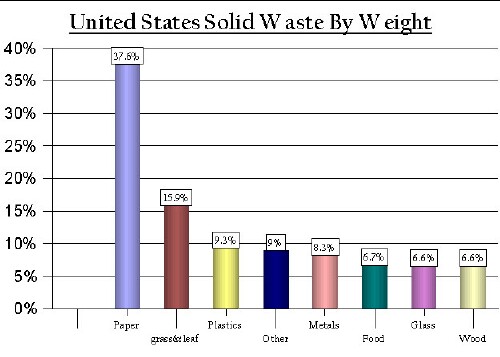
Dehydrating toilet at the Hale-YMCA Community Gardens
As this graph shows, over 60% of our landfill waste is organic and could be recycled or composted if Americans weren't so concerned with convenience over environmental degradation:

Worms are marvelous animals that can convert organic wastes into safe soil ingredients. There are three versions of the produced soil material:
Vermicompost is richer in many nutrients than compost produced by other compostingn methods. It is also rich in microbial life which helps break down nutrients already present in the soil into plant-available forms. Unlike other compost, worm castings also contain worm mucus which keeps nutrients from washing away with the first watering and holds moisture better than plain soil. Vermicompost benefits soil by
The best species of worms for vermiculture are:
The New River Valley Master Gardeners granted the YMCA at Virginia Tech $750 to install a vermiculture facility in the Hale-YMCA Community Gardens.
Besides learning much about vermiculture from web pages and books, the first order of business was to determine what kind and size of facility to build with the funds available. The total surface area is governed by the rule "one square foot of surface area exposed to the atmosphere for each pound of waste to be processed each week".
Here are some options for the facility.
Eventually we would like to have a worm bin similar to one in Raleigh NC:
Dimensions are 4'x8'x(40"-front/46"-back). |
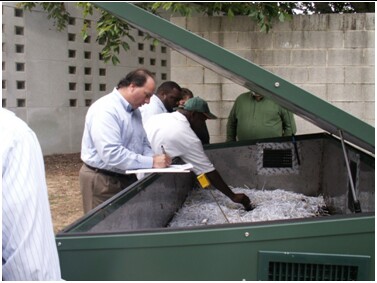 |
Feeding the worms: 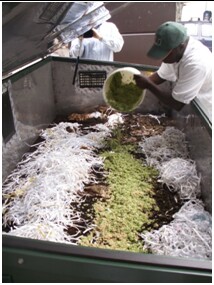 |
Harvesting the worm castings: Harvest Grate and scraper bar: hand operated crank at each end of unit to pull scraper bar across grate to agitate castings, castings then fall below grate to be collected, analyzed, and stored. |
It will handle up to 50-lbs of kitchen waste per day. Its cost is probably several thousand dollars, much more than this project has to spend.
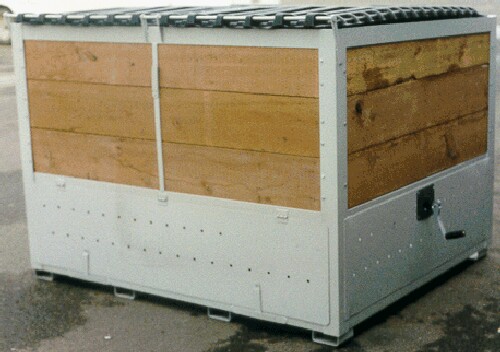 |
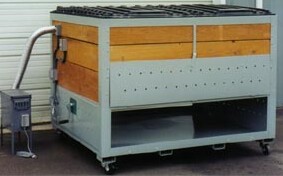 |
![]()
"The key feature is that it is all done AUTOMATICALLY with the vermicast solid falling to waiting trays, as the worm body action expels it from the Vermi-Converter. Then via a unique surface tension effect the liquid quite literally runs backwards to the collector tray and is automatically pumped back into the Vermi-Converter at a controlled rate, until it too is ultimately converted to a ready to use liquid fertilizer.
The whole unit is self contained and powered freely by the sun's energy, a sealed battery stores the electrical energy converted from sunlight, to power the sequence timer and the recirculation pump. The sequence timer can be programmed for a variety of spraying duration's and intervals, so as to ensure it can be used in any location, with any type of green waste."
Cost is several thousand dollars.
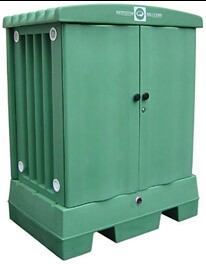 |
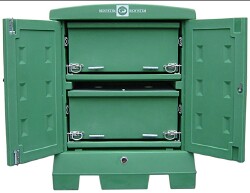 |
"Each self-contained module is capable of processing 15-20 lbs. of material per day, and can be connected in series to other modules, as the need for additional capacity arises. Developed for either indoor or outdoor operation. A stacking, drawer-like design and user-friendly harvesting mechanism provide a space saving solution for efficient, in-vessel processing. Optional thermostat controlled ventilation requires 110 VAC. No plumbing required. The system is also rodent proof, and has a key lock apparatus for vandalism resistance. Please note: the latest production models have 3 breaker bar handles per drawer (the picture shows only 2 per drawer).
Features and Benefits
$5,480 + SH
![]()
"The Vermicondo's container consists of a series of shelves, an important design feature that eliminates the need to muck through worm leftovers. Worms, worm bedding (peat moss or newspaper), and scraps all start at the bottom. The worms eat everything they can find, and when they're finished they move up a layer and leave behind a tray of beautiful organic soil.
Levitt Goodman Architects designed the Vermicondo, a multi-level condo for worms. It appears that worms are upwardly mobile, and by designing it in layers, the worms start on the lower floor, eat all the waste there and then move upstairs. To top it all off, like any TreeHugger building, it has a green roof of wheatgrass.
A tower of slick back-painted acrylic sitting upon a stainless steel colonnade.
The internal multi-tray design allows for tidy operation; from adding organic waste, self-separating the red wigglers from the nutrient rich worm castings to handy "grey water" collection. Of course an address of this sophistication is topped with a green roof of kitchen herbs or what ever your green thumb desires."
$1500 + SH
We may start with the Worm Wigwam:
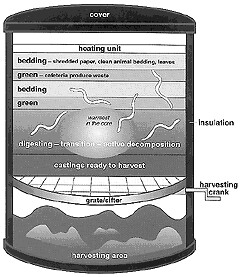
It is 3' tall x 3' diameter, 86 lbs. 15-18 lbs (15,000-18,000) worms. It can handle ~15-lbs of kitchen waste & shredded paper per day. "Layers of green cafeteria waste and other organic materials are placed on top of a metal grate. Most of the decomposition occurs in the warm core of the pile. The 10,000 worms not only process the waste through digestion, but their constant movement also aerates the organic mass. A steel grate separates the processing area where the worms live from the harvest area where the vermicompost falls. A crank on the side of the unit functions like a flour sifter, breaking up the mulch so it can fall through the grate.
Cost is in the range of $600-$700. Some places to purchase:
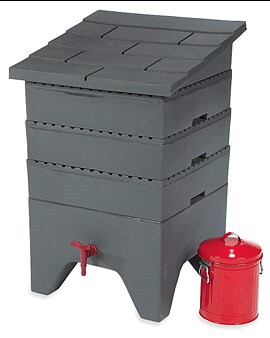 |
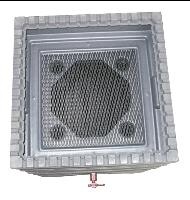 |
Dimensions: 30.5" tall x 19.75" square. Will hold 15-20 lbs of worms.
"This expandable system operates the same as the other stacking tray units that we offer. However, the quality of the plastic and the space saving contemporary design truly set it apart from all other vermiculture systems on the market. Made to resemble weathered stone, the Worm Chalet will compliment any garden or patio setting. Light weight, interchangeable, grip slotted trays are easily added or removed for harvesting or quick cleaning. Bottom liquid catchment level features a spigot for nutritious tea collection. Triple wall design features an insulating air core layer that operates as a passive climate control mechanism, moderating temperature fluctuations. Tapered lid prevents water pooling. Protection from direct sun and extreme temperatures is required for optimum performance and worm happiness."
"As long as the level of soil is close enough to the top where they can reach the next level, the worms will just keep going upward, so when they reach the top box, just place it as the bottom box, empty the castings from the bottom and middle boxes into your garden and start the whole process over again.
Made from UV stabilized plastic that is durable and long lasting it comes with metal sieve separators, it can be used indoors or outdoors as is convenient, has a one year warranty and ships at 79 pounds."
Video about vermicomposting in the Worm Chalet
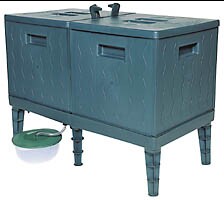
"With its dual bin design and proprietary Migrating Control Device Lever, the worms are able to laterally self separate from the finished compost and migrate over to the new food in the alternate bin - with minimal disturbance to their environment and breeding cycles. It's like having two worm bins on one! This unique, double bin feature allows you to maintain a never ending supply of nutrient rich castings from one bin, without disrupting the composting process in the other.Good air flow is accomplished by ventilation slots throughout the unit, maintaining maximum surface oxygenation for efficient, rapid, aerobic vermi-composting. A liquid collector tray with overflow safety valve allows for the simple and clean dispensing of nutrient-rich liquid fertilizer (tea). These units are self-contained (worms can't easily escape), odorless, fly / vermin resistant, and can be used indoors year round (outdoors in shade during temperate months only). 32 page instruction booklet, vermiculture book, instructional CD-ROM, coir bedding, starter castings, compost bucket, and worm tea drainage kit are all included at no extra charge."
$187 + SH
Review of Worm-A-Roo & lateral-movement composting systems
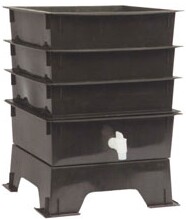 |
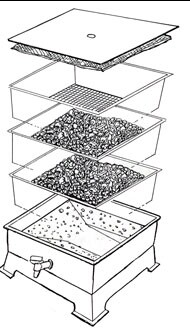 |
This bin works on the principle of upward migration. After the first tray is fed until it is full, a second tray is placed on top. By the time the last tray is full, most of the worms will have left the original tray. The vermicompost in that tray is then dumped out, and the tray moved to the top of the stack.
Each bin comes with coconut coir bedding, manufacturer's instructions, and some important instructions and tips from Gardengold.
3-tray: $67 + $19 SH |
4-tray: $72 + $21 SH |
5-tray: $77 + $23 SH |
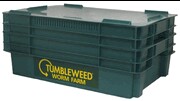 |
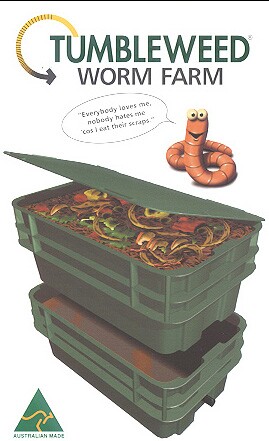 |
"The Tumbleweed Worm Farm is comprised of two sturdy polypropylene boxes, which are nested inside each other. The upper box has a perforated floor and a lid, and the lower box is fitted with a drain sprout. By having the worms in the top portion of the bin (kitchen scraps/organic waste is placed) the waste (liquid tea) filters through the perforated holes into the bottom bin that can be combined with water for use as an organic fertilizer rich in nutrients. As the worms actually eat the bacteria in the decomposed food there is no odor to worry about, simply add your scraps and see the results!
Extra boxes are NOT required. Worms produce more liquid waste than solid as their diet has a high percentage of water. Consequently the build up of solid castings is slow and it will take well over a year to fill the top box with castings.
The bottom box or "catcher box" collects all the valuable liquid waste which is a by product of the worms. This can be used as a fertilizer on your garden by diluting it with equal amounts of water. There is a drain hole so that this can be poured off and used as required."
$90 + SH
This is a small vermicomposting system for households:
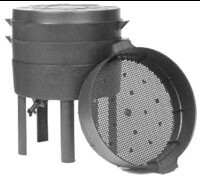 |
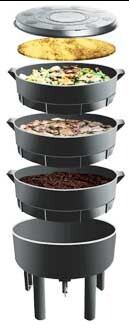 |
It is 29" high x 20" deep. "The perforated stacking trays allow the worms to separate from their
castings automatically, making it very easy for the gardener to harvest
the resulting "worm castings." The trays rotate so that there is always one available for garbage, while the others compost.
The handy spigot allows you to capture the "worm tea" — a rich liquid amendment your plants will love. Sturdy, odorless, and pest-resistant, this earth-friendly composting system is made from 100% post-consumer recycled plastic. Designed to be used indoors or out in warmer climates, it comes with complete instructions. Ideal composting temperature is 60 to 80°F. Australia.
Worms not included. Find composting worms online at www.findworms.com."
Cost is in the range of $100-$150.
Some places to purchase:
Main factors for maintaining a vermiculture facility:
A part-time manager will have the following responsibilities:

L. David Roper, http://arts.bev.net/RoperLDavid/; roperld@vt.edu
04-Jan-2011